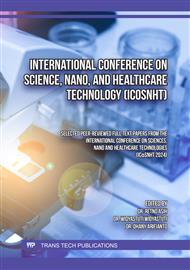[1]
Q. Chen et al., "Fast and sensitive detection of foodborne pathogen using electrochemical impedance analysis, urease catalysis and microfluidics," Biosens. Bioelectron., vol. 86, p.770–776, 2016.
DOI: 10.1016/j.bios.2016.07.071
Google Scholar
[2]
N. Shoaie, M. Forouzandeh, and K. Omidfar, "Voltammetric determination of the Escherichia coli DNA using a screen-printed carbon electrode modified with polyaniline and gold nanoparticles," Microchim. Acta, vol. 185, no. 4, p.1–9, 2018.
DOI: 10.1007/s00604-018-2749-y
Google Scholar
[3]
B. Thakur et al., "Rapid detection of single E. coli bacteria using a graphene-based field-effect transistor device," Biosens. Bioelectron., vol. 110, p.16–22, 2018.
DOI: 10.1016/j.bios.2018.03.014
Google Scholar
[4]
N. Khunrattanaporn, P. Rijiravanich, M. Somasundrum, and W. Surareungchai, "Highly sensitive electrochemical detection of genomic DNA based on stem loop probes structured for magnetic collection and measurement via metalised hollow polyelectrolyte shells," Biosens. Bioelectron., vol. 73, p.181–187, 2015.
DOI: 10.1016/j.bios.2015.05.068
Google Scholar
[5]
W. Wu, S. Zhao, Y. Mao, Z. Fang, X. Lu, and L. Zeng, "A sensitive lateral flow biosensor for Escherichia coli O157: H7 detection based on aptamer mediated strand displacement amplification," Anal. Chim. Acta, vol. 861, p.62–68, 2015.
DOI: 10.1016/j.aca.2014.12.041
Google Scholar
[6]
M. Xu, R. Wang, and Y. Li, "Electrochemical biosensors for rapid detection of Escherichia coli O157:H7," Talanta, vol. 162, p.511–522, 2017.
DOI: 10.1016/j.talanta.2016.10.050
Google Scholar
[7]
J. M. Ismail et al., "Synthesis of Zinc Oxide Nanoparticles via Cellar Spider Extract for Enhanced Functional Properties in Antimicrobial Activities," Int. J. Nanoelectron. Mater., vol. 17, no. June Special issue, p.203–210, 2024.
DOI: 10.58915/ijneam.v17iJune.856
Google Scholar
[8]
M. N. A. Uda et al., "Analysis on Silica and Graphene Nanomaterials Obtained From Rice Straw for Antimicrobial Potential," Int. J. Nanoelectron. Mater., vol. 17, no. Special issue, p.221–228, 2024.
DOI: 10.58915/ijneam.v17iJune.861
Google Scholar
[9]
M. N. Afnan Uda et al., "Aluminium Interdigitated Electrode with 5.0 µm Gap for Electrolytic Scooting," Int. J. Nanoelectron. Mater., vol. 17, no. Special issue, p.237–243, 2024.
DOI: 10.58915/ijneam.v17iJune.863
Google Scholar
[10]
M. Isa et al., "Arthropods-mediated Green Synthesis of Zinc Oxide Nanoparticles using Cellar Spider Extract: A Biocompatible Remediation for Environmental Approach," Int. J. Nanoelectron. Mater., vol. 17, no. Special Issue, p.211–219, 2024.
DOI: 10.58915/ijneam.v17iJune.860
Google Scholar
[11]
L. O. Agbolade et al., "Revisiting the Optoelectronic Properties of Graphene: A DFT Approach," Int. J. Nanoelectron. Mater., vol. 17, no. 1, p.76–88, 2024.
DOI: 10.58915/ijneam.v17i1.476
Google Scholar
[12]
U. Hashim et al., "Advancing COVID-19 Detection: High-Performance RNA Biosensing via Electrical Interactions," Int. J. Nanoelectron. Mater., vol. 17, no. June Special issue, p.229–235, 2024.
DOI: 10.58915/ijneam.v17iJune.862
Google Scholar
[13]
Q. Guo et al., "DNA-based hybridization chain reaction and biotin–streptavidin signal amplification for sensitive detection of Escherichia coli O157:H7 through ELISA," Biosens. Bioelectron., vol. 86, p.990–995, 2016.
DOI: 10.1016/j.bios.2016.07.049
Google Scholar
[14]
B. Pang et al., "Development of a low-cost paper-based ELISA method for rapid Escherichia coli O157:H7 detection," Anal. Biochem., vol. 542, p.58–62, 2018.
DOI: 10.1016/j.ab.2017.11.010
Google Scholar
[15]
C. Song, J. Li, J. Liu, and Q. Liu, "Simple sensitive rapid detection of Escherichia coli O157:H7 in food samples by label-free immunofluorescence strip sensor," Talanta, vol. 156–157, p.42–47, 2016.
DOI: 10.1016/j.talanta.2016.04.054
Google Scholar
[16]
M. N. Afnan Uda, A. B. Jambek, U. Hashim, and M. N. A. Uda, "Electrical DNA Biosensor Using Aluminium Interdigitated Electrode for Salmonella Detection," IOP Conf. Ser. Mater. Sci. Eng., vol. 743, no. 1, 2020.
DOI: 10.1088/1757-899X/743/1/012022
Google Scholar
[17]
M. N. A. Uda et al., "Harumanis Mango: Perspectives in Disease Management and Advancement using Interdigitated Electrodes (IDE) Nano-Biosensor," IOP Conf. Ser. Mater. Sci. Eng., vol. 864, no. 1, 2020.
DOI: 10.1088/1757-899X/864/1/012180
Google Scholar
[18]
M. N. A. Uda, U. Hashim, S. C. B. Gopinath, M. N. A. Uda, N. A. Parmin, and A. M. Isa, "Label-free aptamer based biosensor for heavy metal detection," AIP Conf. Proc., vol. 2291, no. November, 2020.
DOI: 10.1063/5.0022834
Google Scholar
[19]
R. D. A. A. Rajapaksha, N. A. N. Azman, M. N. A. Uda, U. Hashim, S. C. B. Gopinath, and C. A. N. Fernando, "Multichannel PDMS microfluidic based nano-biolab-on-a-chip for medical diagnostics," AIP Conf. Proc., vol. 2045, no. March 2016, 2018.
DOI: 10.1063/1.5080833
Google Scholar
[20]
M. N. Afnan Uda et al., "Nano-micro-mili Current to Mili Voltage Amplifier for Amperometric Electrical Biosensors," IOP Conf. Ser. Mater. Sci. Eng., vol. 743, no. 1, 2020.
DOI: 10.1088/1757-899X/743/1/012021
Google Scholar
[21]
H. M. Azwatul et al., "Plant-based green synthesis of silver nanoparticle via chemical bonding analysis," Mater. Today Proc., no. January, 2023.
DOI: 10.1016/j.matpr.2023.01.005
Google Scholar
[22]
P. V Savaliya, S. B. Somani, and V. V Shete, "A Bluetooth Tele Health, Household Security and Industry Safety Realization by Android Smartphone," Int. J. Adv. Res. Comput. Commun. Eng., vol. 4, no. 6, p.382–385, 2015.
Google Scholar
[23]
R. Bhattacharya, N. Bandyopadhyay, and S. Kalaivani, "Real time Android app based respiration rate monitor," Proc. Int. Conf. Electron. Commun. Aerosp. Technol. ICECA 2017, vol. 2017-Janua, p.709–712, 2017.
DOI: 10.1109/ICECA.2017.8203633
Google Scholar
[24]
G. Scandurra, G. Giusi, and C. Ciofi, " Ultra-low noise, single JFET voltage pre-amplifier for low frequency noise measurements," p.2–5.
DOI: 10.3390/electronics8101197
Google Scholar
[25]
R. H. Rakin, A. Siam, M. R. Hossain, and H. U. Zaman, "A low-cost and portable electrocardiogram (ECG) machine for preventing diagnosis," 1st Int. Conf. Robot. Electr. Signal Process. Tech. ICREST 2019, p.48–53, 2019.
DOI: 10.1109/ICREST.2019.8644425
Google Scholar
[26]
M. Nur et al., "Conductometric immunosensor for specific Escherichia coli O157 : H7 detection on chemically funcationalizaed interdigitated aptasensor," Heliyon, vol. 10, no. 5, p. e26988, 2024.
DOI: 10.1016/j.heliyon.2024.e26988
Google Scholar
[27]
M. N. Afnan Uda, A. B. Jambek, U. Hashim, M. N. A. Uda, and M. A. F. Bahrin, "Aluminium Interdigitated Electrode Based Biosensor for Specific ssDNA Target Listeria Detection," IOP Conf. Ser. Mater. Sci. Eng., vol. 743, no. 1, 2020.
DOI: 10.1088/1757-899X/743/1/012032
Google Scholar
[28]
M. N. Afnan Uda, A. B. Jambek, U. Hashim, and M. N. A. Uda, "Development of Voltage Amplifier Electronic Reader for Multiplex Detection of Two Electrode Electrical Biosensors," IOP Conf. Ser. Mater. Sci. Eng., vol. 743, no. 1, 2020.
DOI: 10.1088/1757-899X/743/1/012019
Google Scholar


